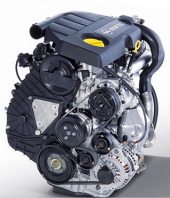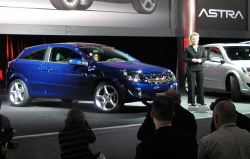For years enthusiasts have asked GM to offer its European cars in the U.S. (An Opel Omega rebadged as a Cadillac Catera didn’t count.) This fall they’ll start to get their wish, when the Opel Astra goes on sale as the Saturn Astra, with more German-engineered Opels rebadged as Saturns to follow.
I fear that the Astra will not sell as well as many people expect, for one reason: the engine. Opel offers over wide range of four-cylinder engines in the car:

- 90-horsepower 1.4-liter
- 105- and 115- horsepower 1.6-liters
- 140-horsepower 1.8-liter
- 180-horsepower 1.6-liter turbo
- 200- and 240-horsepower 2.0-liter turbos
- 90-horsepower 1.3-liter turbo-diesel
- 110- and 125-horsepower 1.7-liter turbo-diesels
- 150-horsepower 1.9-liter turbo-diesel
But as a Saturn, the Astra will initially be available with only one engine, the 140-horsepower 1.8-liter gasoline-powered four. I suspect they selected this engine because it’s the strongest non-turbo four, with plans for a turbo Astra Red Line at a later date.
But the time to offer a strong engine is at the launch, not later. With an established model it’s possible to start with an acceptable engine, and add performance variants later. But this is a new nameplate, and the public is going to form its impression of the Astra based on what is offered at the launch. By the time the Red Line shows up these impressions will have formed and solidified.
 How does a 140-horsepower, 1.8-liter four stack up? Pretty well against Honda (the non-Si Civic engine has similar specs), Toyota, and Hyundai. But I suspect that the Saturn will often be compared to the Mazda3 and the VW Rabbit. Even without considering the 263-horsepower turbo four MazdaSpeed3, the Japanese car’s engines outshine the upcoming Saturn’s, with a 150-horsepower 2.0-liter and a 160-horsepower 2.3-liter. The Rabbit is offered with a 150-horsepower 2.5-liter five-cylinder engine. Which kicks out only ten extra horses at its peak, but has a much stronger midrange. Or you can step up to the GTI, with a 200-horsepower 2.0-liter turbo four.
How does a 140-horsepower, 1.8-liter four stack up? Pretty well against Honda (the non-Si Civic engine has similar specs), Toyota, and Hyundai. But I suspect that the Saturn will often be compared to the Mazda3 and the VW Rabbit. Even without considering the 263-horsepower turbo four MazdaSpeed3, the Japanese car’s engines outshine the upcoming Saturn’s, with a 150-horsepower 2.0-liter and a 160-horsepower 2.3-liter. The Rabbit is offered with a 150-horsepower 2.5-liter five-cylinder engine. Which kicks out only ten extra horses at its peak, but has a much stronger midrange. Or you can step up to the GTI, with a 200-horsepower 2.0-liter turbo four.
Against these competitors, the Saturn is bringing a knife to a gunfight. Doesn’t matter how sharp that knife is, it isn’t going to cut it.
Instead, GM needs to learn from its past mistakes. The Pontiac GTO and Chevrolet SSR both received attention-grabbing power in their second years, which was a year too late to effectively grab the public’s attention. Even the Pontiac Solstice and Saturn SKY are beginning to suffer because the public thinks of them as 170-horsepower cars. The 260-horsepower turbos were introduced too long after the intro to affect overall perceptions of the models.
I’m not saying that most people would buy the car with the more powerful engine, only that a more powerful engine is needed in addition to (not instead of) the 1.8 for image reasons.
I also don’t mean to imply that only GM makes this mistake. Ford has dug itself into a deep hole partly by introducing the Five Hundred, Freestyle, and Fusion with aging 3.0-liter V6 engines. They’ll all eventually get a new 3.5-liter V6, the big cars in a few months (along with the Taurus name change), but here as well public perceptions have solidified.
You can add a more powerful engine later, as long as the engine at intro is already powerful enough to grab people’s attention. Launching the Chrysler 300 with the 340-horsepower 5.7-liter “Hemi” V8 and then adding the 425-horsepower 6.1-liter SRT later worked because even the 5.7 was strong enough to force people to take notice.
The Saturn Astra’s 140-horsepower 1.8-liter isn’t going to grab anyone’s attention. The car literally needs a stronger launch.
Related blog entries:
Saturn Astra introduction at the Chicago Auto Show
Are overseas models a solution for Detroit?